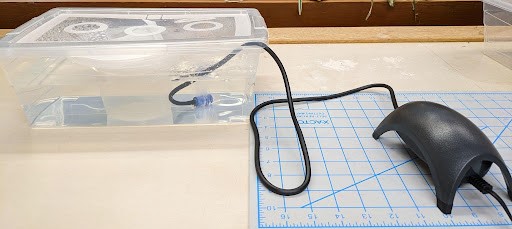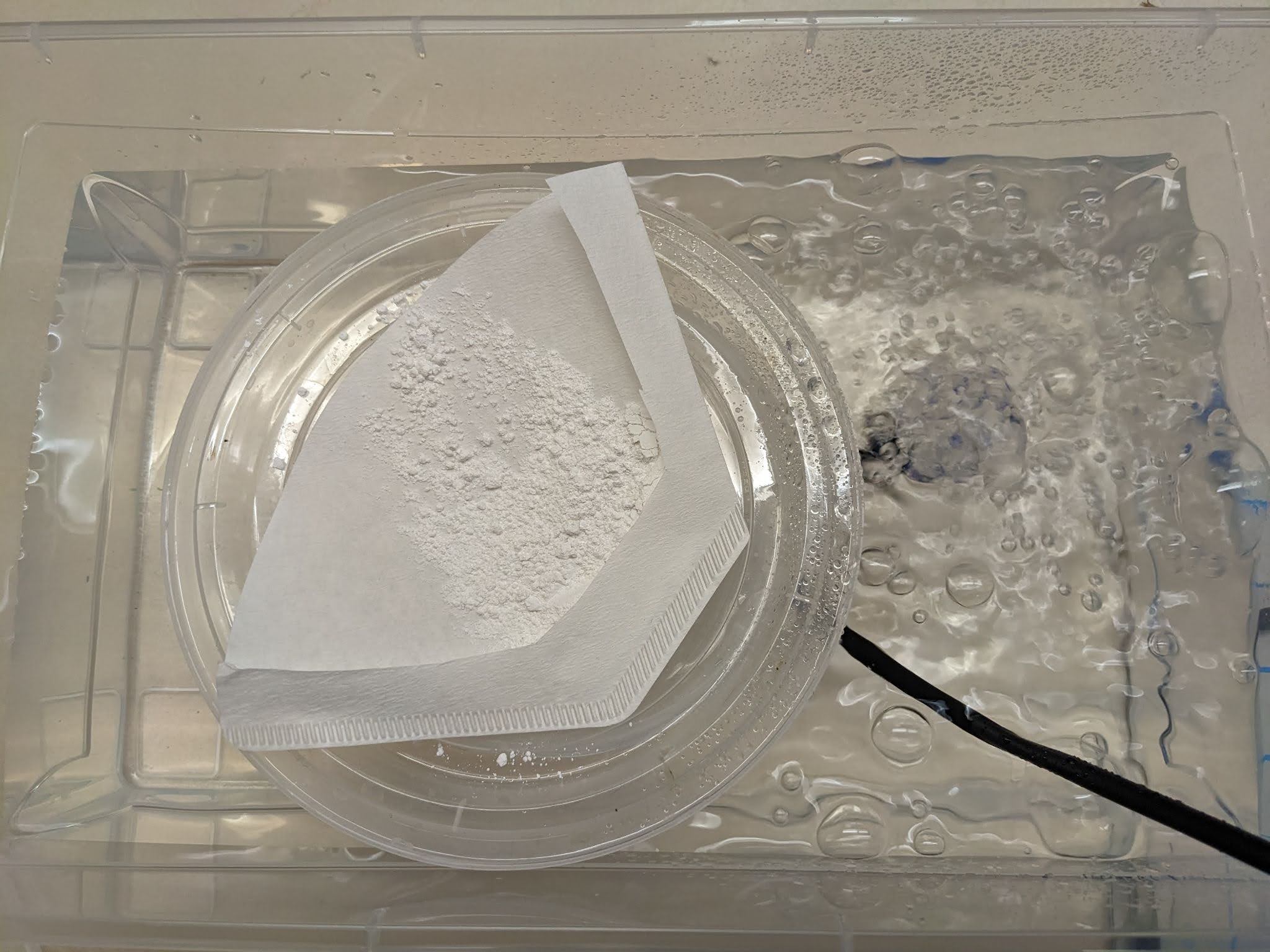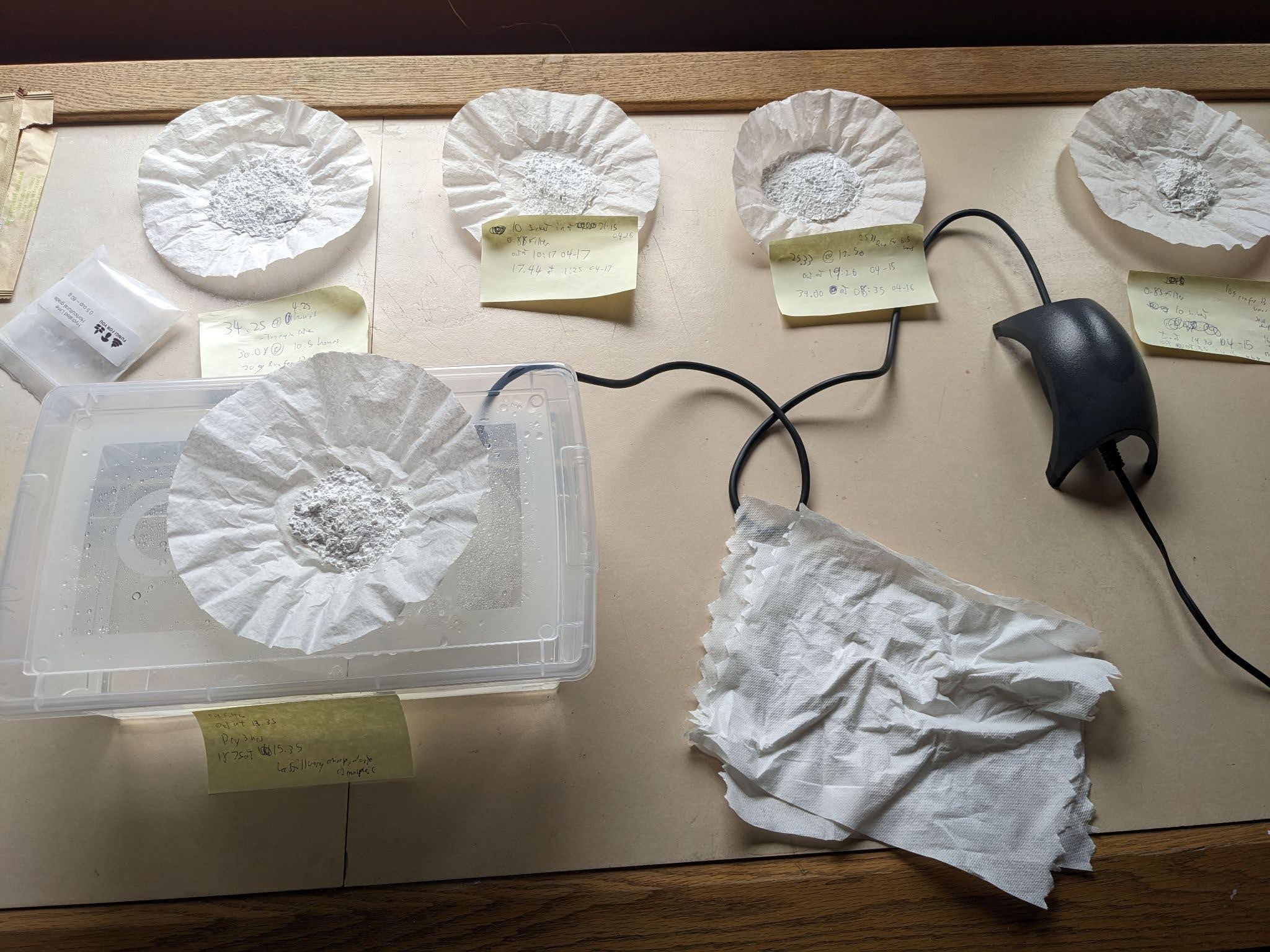
Compiled for the EMM Lab by W. Kees Schuller. With thanks to Swati Mehta for web support, feedback, and experimental work
Original Design: https://openair-collective.github.io/openair-cyan/
Additional resources used: The OpenAir Discord server

CYAN 1.0 is an open-source, desktop scale Direct Air Capture (DAC) device designed by Dahl Winters with the support of OpenAir. CYAN 1.0 is designed to extract carbon dioxide from the atmosphere by converting calcium hydroxide into precipitated calcium carbonate through carbonatation, and sequester it in a physical form. Accessible, cheap, and easy to use, CYAN 1.0 is a “portable system," per the OpenAir website, that “operates at a small enough scale to empower individuals to tangibly experience carbon removal” by getting “people actively thinking and sharing their carbon footprint and their role in the carbon cycle[1].” CYAN was designed and iterated on by OpenAir as a collective, with multiple members contributing design improvements, chemistry formulas, and providing experimental data to determine the optimal operation of CYAN. While there are multiple iterations and designs of CYAN, the EMM Lab built CYAN 1.0, which is the simplest and most accessible version of CYAN. Future references to CYAN in this document refer to CYAN 1.0.
A DAC device uses chemical processes to extract carbon from carbon dioxide and convert it into a physical form. The carbon then has one of two paths. First, this physical form can be buried, stored, or otherwise used in a way that it will not release the carbon back into the atmosphere. Second, the carbon can be re-released through another chemical process in a controlled way that stores the gaseous carbon and prevents it from re-entering into the atmosphere. CYAN does the former, converting carbon dioxide and calcium hydroxide into calcium carbonate, which is then stored or disposed of.
CYAN is primarily built using cheap, household objects, and can be assembled quickly. The main components are a tub, Tupperware, or other plastic box, an aquarium pump and aeration stone, and a supply of the sorbent (the calcium carbonate used to extract carbon). Once assembled, CYAN is run by adding sorbent to the interior, turning on the aquarium pump for a specified run time (based on the amount of sorbent used), and then removing the sorbent and allowing it to dry.
For the EMM Lab, building CYAN was part of a larger series of experiments with carbon, investigations of carbon thinking, climate change legibility, and a study of OpenAir as climate praxis.
CYAN itself was built in order to be used, contributing experimental data to OpenAir’s experiments and investigations into building and optimizing CYAN, and in order to assess its feasibility for future experiments we were designing. One of these experiments (see Responses and Reflections for a more in-depth discussion) involved using wollastonite as the sorbent, while one of the planned projects involved using the sequestered carbon to produce public-facing physical outputs to help materialize ideas of carbon capture.
This latter project would have also served to support our investigations into affective and social dimensions of climate activism. Returning to CYAN itself, we also built it in order to provide a lens through which to investigate the affective and social dimensions of the work being done by OpenAir’s open-source DAC projects.
CYAN is relatively simple to both source parts for and build, with clear and thorough documentation provided by OpenAir. That said, the EMM Lab’s commitment to not buying from Amazon and similar carbon-intensive mega-corporations did lengthen the process, due to stock issues in local stores delaying finding the specific components (or near equivalents) listed in OpenAir’s documentation. However, once the parts were sourced, CYAN was built in around one hour of work, shared between three members of the EMM Lab.
Once built, EMM Lab ran a short trial to trouble-shoot any possible problems, followed by two rounds of experiments with CYAN. We primarily tested its output and function under different conditions, and gathered data to both contribute to OpenAir’s data archive, and in order to draw our own conclusions about the project. The initial trial run took place December 23rd 2022 to January 5th, 2023. The first round of experiments ran from April 7th, 2023 to April 21st, 2023. The second round of experiments, conducted to confirm the results from round one, and to test the effects of environmental conditions on CYAN, ran from June 8th, 2023 to June 21st, 2023. Data analysis followed.
At this time, no further projects or experiments using CYAN have been completed by the EMM Lab.
CYAN is a desktop-scale DAC device that sequesters carbon by expediting a chemical reaction between calcium hydroxide, water, and airborne carbon dioxide that outputs water, oxygen, and calcium carbonate. While other DAC devices and systems use other methods, CYAN relies on having a fresh supply of calcium hydroxide (the sorbent) to convert into calcium carbonate. The calcium carbonate is then stable and sequesters the carbon unless otherwise acted upon.

The need for fresh calcium hydroxide, combined with CYAN’s assembly (a coffee filter above the water level filled with sorbent, inside a sealed Tupperware filled with water) requires active maintenance at the beginning and end of cycles, unlike other DAC systems. Operating CYAN involved measuring out specific weights of sorbent, ensuring that the filter and sorbent were both just above the water level, and then turning on the air filter for a predetermined length of time, so as to allow full water saturation of the hydrated lime. After that time, the air filter was turned off, the coffee filter removed and the calcium carbonate was allowed to dry over the next few hours or days. We measured the final weight change in the sorbent over the course of several days, as varying temperatures and environmental conditions led to different drying times, which was relevant experimental data, though did not affect the ultimate outcome. Once the weight of the sorbent had stopped changing, we used formulas provided by OpenAir to measure the weight carbon captured by each test.

Both rounds of testing were modelled after OpenAir’s measurements, using the same parameters for runtime, sorbent weight, and drying time. This allowed us to establish a baseline for our CYAN build before proceeding with any further experiments. Once multiple data points had been collected during each round of testing, data analysis could begin.
CYAN had minimal physical build requirements. Designed to be simple and cheap to build, and easy to use, the project mostly makes use of recycled or household materials. Those components that could not be sourced from recycled or household materials, and that needed to be purchased with lab funds, have been listed here. The prices are listed in Canadian Dollars (CAD).